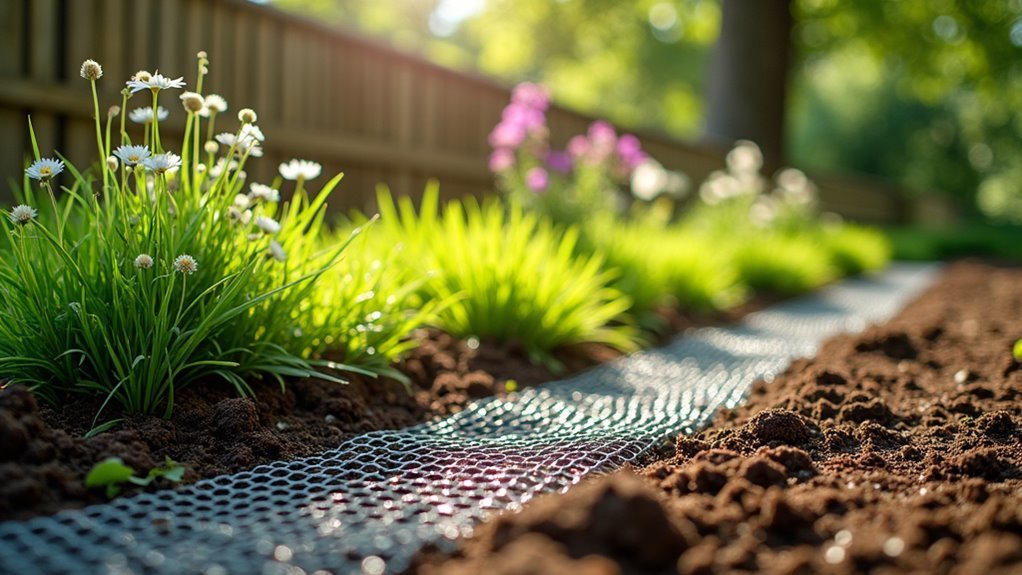You can effectively repel moles by installing underground wire mesh barriers around your garden perimeter, burying galvanized steel mesh 2-3 feet deep. Eliminate their food sources by applying beneficial nematodes to control grubs organically. Improve soil drainage and aeration to create unfavorable conditions, as moles thrive in moist environments. Plant aromatic deterrents like marigolds, daffodils, and alliums throughout your landscape. Maintain proper lawn health with correct mowing heights and regular fertilization to discover extensive mole prevention strategies.
Create Physical Barriers Using Underground Wire Mesh

One of the most reliable methods to protect your garden involves installing underground wire mesh barriers that physically block moles from accessing your plants.
Underground wire mesh barriers provide one of the most dependable physical solutions for blocking moles from reaching your garden plants.
You’ll need to dig a trench 2 to 3 feet deep around your garden’s perimeter. Use galvanized steel mesh that’s at least 24 inches wide, burying 2 feet underground while leaving 6 to 12 inches above ground. This prevents moles from burrowing underneath your barrier.
The sturdy galvanized steel withstands soil pressure and resists mole penetration. While this approach requires significant labor, it provides a long-term solution for larger areas.
For enhanced protection against mole activity, construct small wire cages around vulnerable individual bulbs or plants. These physical barriers effectively establish mole-free zones.
Eliminate Food Sources Through Grub Control
While physical barriers provide excellent protection, controlling moles’ food supply offers another effective approach to reducing their presence in your yard.
Though moles primarily feed on earthworms, managing grub populations can help maintain overall lawn health and reduce secondary pest problems.
Here’s how to implement effective grub control:
- Apply beneficial nematodes – These microscopic organisms target grubs organically while preserving earthworms that maintain soil health.
- Practice regular soil inspection – Monitor for grub activity and apply organic treatments early when populations are manageable.
- Implement cultural practices – Aerate your soil and maintain proper watering schedules to create less favorable conditions for grubs.
Improve Soil Drainage and Aeration

Beyond controlling food sources, modifying your soil’s physical properties creates an environment that naturally discourages mole activity.
You’ll want to improve soil drainage since moles thrive in moist conditions. Aerating the soil enhances oxygen flow and encourages healthier grass that can withstand mole damage. Regular aeration will disrupt mole tunneling patterns, making your lawn less appealing for burrow establishment.
Installing a drainage system helps prevent water accumulation in problem areas. You can’t underestimate how effective this approach is at making your yard inhospitable to moles.
Proper drainage systems eliminate standing water that attracts moles, creating an inhospitable environment that naturally deters these persistent lawn pests.
Maintaining a balanced soil structure through proper aeration and watering practices improves overall lawn health. These combined strategies create conditions that naturally repel moles while promoting a robust, resilient lawn that’s less susceptible to pest problems.
Plant Mole-Repelling Flowers and Ground Cover
Strategic planting transforms your landscape into a natural barrier against moles while creating beautiful garden displays.
You’ll repel these underground pests by selecting flowers and ground cover with scents they find unappealing.
Focus on these effective mole-deterring plants:
- Aromatic flowers – Plant marigolds and daffodils throughout your garden beds, as their natural fragrances create an unwelcoming environment for moles seeking comfortable tunneling areas.
- Strong-scented alliums – Incorporate garlic and onion varieties whose pungent odors effectively deter moles and other garden pests from establishing territory in your yard.
- Fragrant ground cover – Establish creeping thyme and lavender in strategic locations to emit continuous deterrent fragrances while beautifying your landscape.
Regularly rotate and mix these plants throughout your property to maintain consistent mole-repelling effects across your entire outdoor space.
Maintain Proper Lawn Health and Mowing Practices

Since healthy lawns naturally discourage mole activity, you’ll want to focus on proper maintenance practices that create an environment these pests find less attractive.
Start with mowing practices that maintain grass height between 2.5-3 inches, which promotes strong growth and reduces moles’ food source availability. Proper watering and fertilization encourage deep root systems, making soil less appealing for tunneling.
Your lawn care routine should include annual aerating to improve drainage and reduce the moist conditions moles prefer. Don’t forget to reduce thatch buildup by keeping it under half an inch, allowing better air circulation.
Implement overseeding with drought-resistant varieties to create a robust, healthy lawn that’ll effectively repel moles.
Frequently Asked Questions
What Is the Most Effective Mole Deterrent?
You’ll find underground barriers work best for deterring moles. Create trenches 2-3 feet deep, then fill them with rocks or wire mesh to prevent moles from entering your garden effectively.
What Is the Fastest Way to Get Rid of Moles in Your Yard?
You’ll eliminate moles fastest by placing harpoon or pitfall traps in active tunnels and using bromethalin-based worm baits. This combination approach typically works within two days when you monitor tunnels regularly.
What Can I Plant to Keep Moles Away?
You can plant marigolds, daffodils, alliums, and lavender to naturally repel moles. These flowers’ strong scents and toxic properties discourage moles from burrowing. Castor beans also work well since they’re distasteful to moles.
What Do Moles Hate Most?
Moles hate castor oil most because it makes their food taste terrible. You’ll also find they despise strong vibrations, ultrasonic sounds, and pungent plants like garlic that overwhelm their sensitive senses.
In Summary
You’ll find success by combining these strategies rather than relying on just one approach. Start with underground barriers and grub control for immediate results, then focus on long-term soil improvement and plant selection. Don’t forget that consistent lawn maintenance plays a vital role in prevention. With patience and persistence, you’ll create an environment that naturally discourages moles while maintaining a beautiful, healthy landscape that’s resistant to future infestations.





Leave a Reply